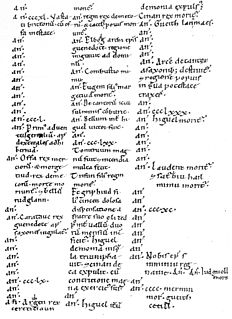 W
WAnnales Cambriae is the title given to a complex of Cambro-Latin chronicles compiled or derived from diverse sources at St David's in Dyfed, Wales. The earliest is a 12th-century presumed copy of a mid-10th century original; later editions were compiled in the 13th century. Despite the name, the Annales Cambriae record not only events in Wales, but also events in Ireland, Cornwall, England, Scotland and sometimes further afield, though the focus of the events recorded especially in the later two-thirds of the text is Wales.
 W
WArmes Prydein is an early 10th-century Welsh prophetic poem from the Book of Taliesin.
 W
WThe Black Book of Carmarthen is thought to be the earliest surviving manuscript written solely in Welsh. The book dates from the mid-13th century; its name comes from its association with the Priory of St. John the Evangelist and Teulyddog at Carmarthen, and is referred to as black due to the colour of its binding. It is currently part of the collection of the National Library of Wales, where it is catalogued as NLW Peniarth MS 1.
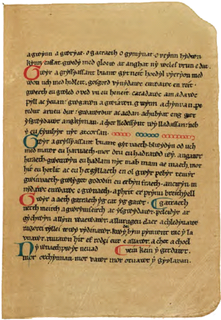 W
WThe Book of Aneirin is a late 13th century Welsh manuscript containing Old and Middle Welsh poetry attributed to the late 6th century Northern Brythonic poet, Aneirin, who is believed to have lived in present-day Scotland.
 W
WThe Book of Llandaff, is the Chartulary, or Register Book of the Cathedral Church of Llandaff, a 12th-century compilation of documents relating to the history of the diocese of Llandaff in Wales. It is written primarily in Latin but also contains a significant amount of Old and Middle Welsh names and marginalia.
 W
WThe Book of Taliesin is one of the most famous of Middle Welsh manuscripts, dating from the first half of the 14th century though many of the fifty-six poems it preserves are taken to originate in the 10th century or before.
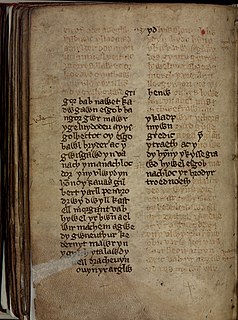 W
WBrut y Tywysogion, also known as Brut y Tywysogyon, is one of the most important primary sources for Welsh history. It is an annalistic chronicle that serves as a continuation of Geoffrey of Monmouth’s Historia Regum Britanniae. Brut y Tywysogion has survived as several Welsh translations of an original Latin version, which has not itself survived. The most important versions are the one in Robert Vaughan's Peniarth MS. 20 and the slightly less complete one in the Red Book of Hergest. The version entitled Brenhinoedd y Saeson combines material from the Welsh annals with material from an English source.
 W
WCronica Walliae is a manuscript of chronological history by Humphrey Llwyd written in 1559. Llwyd translated versions of a medieval text about Wales' history, Brut y Tywysogion, from Welsh and Medieval Latin into English. He also added historical material from Matthew Paris and Nicholas Trivet, as well as from other well known historians. It is the first history of Wales written in English and contains material about ancient rulers, with some material based on legends. Llwyd's work gives a history description of Wales that was originally written in the early part of the sixteenth century by Sir John Prise of Brecknockshire, Wales.
 W
WThe Cwrtmawr Manuscripts are a collection of 1,549 volumes of medieval Welsh documents, mainly texts of Welsh literature, collected by John Humphreys Davies, who lived at Cwrtmawr near Llangeitho in Ceredigion and was principal of the University College of Wales, Aberystwyth from 1919-1926. The manuscripts are now kept in the National Library of Wales.
 W
WCyfoesi Myrddin a Gwenddydd ei Chwaer is an anonymous Middle Welsh poem of uncertain date consisting of 136 stanzas, mostly in englyn form. Myrddin, the legendary 6th-century North British bard and warrior, is depicted as being encouraged by his sister Gwenddydd to utter a series of prophecies detailing the future history of the kings of Gwynedd, leading up to an apocalyptic ending. The mood of the poem has been described as "one of despair and of loss of faith and trust in this world".
 W
WCyfraith Hywel, also known as Welsh law, was the system of law practised in medieval Wales before its final conquest by England. Subsequently, the Welsh law's criminal codes were superseded by the Statute of Rhuddlan in AD 1284 and its civil codes by Henry VIII's series of Laws in Wales Acts between 1535 and 1542.
 W
WThe Descriptio Cambriae or Descriptio Kambriae is a geographical and ethnographic treatise on Wales and its people dating from 1193 or 1194. The Descriptio’s author, variously known as Gerald of Wales or as Giraldus Cambrensis, was a prominent churchman of Welsh birth and mixed Norman-Welsh ancestry. It is divided into two books, the first concentrating on the virtues of the Welsh people, and the second on their faults.
 W
WDormarch or possibly Dormarth is a hound, normally used to assist hunters by tracking or chasing the animal that is being hunted, however in Welsh mythology Dormarch's master is Gwynn ap Nudd although formerly owned by Maelgwn Gwynedd, a 6th-century king of Gwynedd.
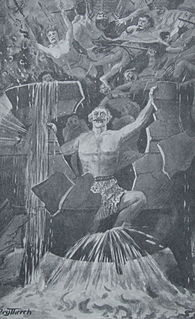 W
WEfnisien fab Euroswydd is a sadistic anti-hero in Welsh mythology, appearing prominently in the tale of Branwen ferch Llŷr, the second branch of the Mabinogi. Described by Will Parker as "a study in the psychopathic personality" and an "embodiment of the forces of anti-social disruption," he is the catalyst of the tale's ultimate tragedy, and is largely responsible for the destruction of both Ireland and the Island of the Mighty. He is the son of Euroswydd and Penarddun, twin brother to Nisien, and half-brother to Brân the Blessed, Manawydan, and Branwen. The Welsh Triads call Llŷr one of the Three Exalted Prisoners of Britain for his captivity at Euroswydd's hands; this is likely to a lost tradition of the birth of Penarddun's younger sons.
 W
WThe Four Ancient Books of Wales is a term coined by William Forbes Skene to describe four important medieval manuscripts written in Middle Welsh and dating from the 13th, 14th, and 15th centuries. They contain primarily texts of poetry and prose, some of which are contemporary and others which may have originated from traditions dating back to as early as the sixth and seventh centuries. These also contain some of the earliest native Welsh references to King Arthur.
 W
WGerald of Wales was a Cambro-Norman archdeacon of Brecon and historian. As a royal clerk to the king and two archbishops, he travelled widely and wrote extensively. He studied and taught in France and visited Rome several times, meeting the Pope. He was nominated for several bishoprics but turned them down in the hope of becoming Bishop of St Davids, but was unsuccessful despite considerable support. His final post was as Archdeacon of Brecon, from which he retired to academic study for the remainder of his life. Much of his writing survives.
 W
WGildas — also known as Gildas the Wise or Gildas Sapiens — was a 6th-century British monk best known for his scathing religious polemic De Excidio et Conquestu Britanniae, which recounts the history of the Britons before and during the coming of the Saxons. He is one of the best-documented figures of the Christian church in the British Isles during the sub-Roman period, and was renowned for his Biblical knowledge and literary style. In his later life, he emigrated to Brittany where he founded a monastery known as St Gildas de Rhuys.
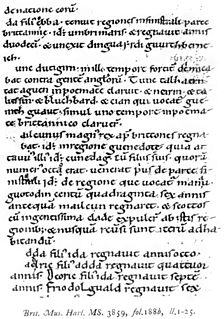 W
WThe Harleian genealogies are a collection of Old Welsh genealogies preserved in British Library, Harley MS 3859. Part of the Harleian Library, the manuscript, which also contains the Annales Cambriae and a version of the Historia Brittonum, has been dated to c. 1100, although a date of c.1200 is also possible. Since the genealogies begin with the paternal and maternal pedigrees of Owain ap Hywel Dda, the material was probably compiled during his reign. The collection also traces the lineages of less prominent rulers of Wales and the Hen Ogledd. Some of the genealogies reappear in the genealogies from Jesus College MS 20.
 W
WHistoria regum Britanniae, originally called De gestis Britonum, is a pseudohistorical account of British history, written around 1136 by Geoffrey of Monmouth. It chronicles the lives of the kings of the Britons over the course of two thousand years, beginning with the Trojans founding the British nation and continuing until the Anglo-Saxons assumed control of much of Britain around the 7th century. It is one of the central pieces of the Matter of Britain.
 W
WThe History of the Kings, or Brut y Brenhinedd, is a Welsh translation of Geoffrey of Monmouth’s Historia Regum Britanniae. The manuscript, which was copied in the late fifteenth century, is probably the only illustrated Welsh-language medieval narrative. It is part of the Peniarth Manuscripts collection at the National Library of Wales.
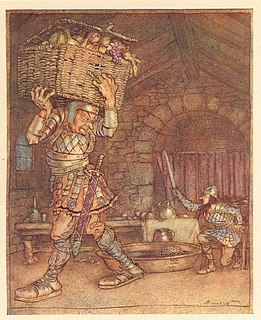 W
WLludd and Llefelys is a Middle Welsh prose tale written down in the 12th or 13th century; it was included in the Mabinogion by Lady Charlotte Guest in the 19th century. It tells of the Welsh hero Lludd Llaw Eraint, best known as King Lud son of Heli in Geoffrey of Monmouth's Historia Regum Britanniae, and his brother Llefelys.
 W
WThe Mabinogion are the earliest prose stories of the literature of Britain. The stories were compiled in Middle Welsh in the 12th–13th centuries from earlier oral traditions. There are two main source manuscripts, created c. 1350–1410, as well as a few earlier fragments. The title covers a collection of eleven prose stories of widely different types, offering drama, philosophy, romance, tragedy, fantasy and humour, and created by various narrators over time. There is a classic hero quest, "Culhwch and Olwen"; a historic legend in "Lludd and Llefelys," complete with glimpses of a far off age; and other tales portray a very different King Arthur from the later popular versions. The highly sophisticated complexity of the Four Branches of the Mabinogi defies categorisation. The stories are so diverse that it has been argued that they are not even a true collection.
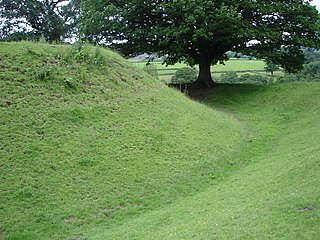 W
W"Owain Glyndŵr's Court", also known as "Sycharth" or "The Court of Owain Glyndŵr at Sycharth", is a cywydd by the Welsh bard Iolo Goch. It describes and celebrates the hall and household of his patron, the nobleman Owain Glyndŵr, at Sycharth in Powys. It cannot be dated exactly, but was probably written about 1390, before Glyndŵr's revolt against the English crown. It survives in as many as 24 manuscripts.
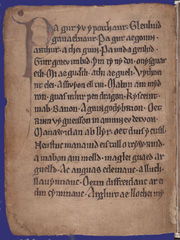 W
WPoem 31 of the Black Book of Carmarthen, a mid-13th century manuscript, is known from its first line as Pa gur yv y porthaur? or Pa gur, or alternatively as Ymddiddan Arthur a Glewlwyd Gafaelfawr. It is a fragmentary, anonymous poem in Old Welsh, taking the form of a dialogue between King Arthur and the gatekeeper Glewlwyd Gafaelfawr, in which Arthur boasts of his own exploits and those of his companions, especially Cai the Fair. Pa gur is notable for being one of the earliest vernacular Arthurian works, and for alluding to several early adventures of Arthur which are now lost. Its precise age is not known and has been the subject of wide-ranging disagreement, but scholarly opinion now tends to favour a date of c. 1100.
 W
WPeniarth 20 is an early Welsh manuscript, written on parchment, that is part of the Peniarth collection in the National Library of Wales. It is also known as the Chronicle of the Princes because it contains an important version of the chronicle Brut y Tywysogion. Daniel Huws, the leading authority on Welsh manuscripts, has argued that the majority of Peniarth 20 dates from circa 1330. A date around the 15th century had previously been offered by J. Gwenogvryn Evans.
 W
WPeredur son of Efrawg is one of the Three Welsh Romances associated with the Mabinogion. It tells a story roughly analogous to Chrétien de Troyes' unfinished romance Perceval, the Story of the Grail, but it contains many striking differences from that work, most notably the absence of the French poem's central object, the grail.
 W
WPreiddeu Annwfn or Preiddeu Annwn is a cryptic poem of sixty lines in Middle Welsh, found in the Book of Taliesin. The text recounts an expedition with King Arthur to Annwfn or Annwn, the Welsh name for the Celtic Otherworld.
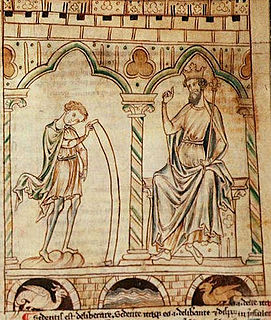 W
WThe Prophetiæ Merlini is a Latin work of Geoffrey of Monmouth circulated, perhaps as a libellus or short work, from about 1130, and by 1135. Another name is Libellus Merlini.
 W
WThe Red Book of Hergest is a large vellum manuscript written shortly after 1382, which ranks as one of the most important medieval manuscripts written in the Welsh language. It preserves a collection of Welsh prose and poetry, notably the tales of the Mabinogion and Gogynfeirdd poetry. The manuscript derives its name from the colour of its leather binding and from its association with Hergest Court between the late 15th and early 17th century.
 W
WThe Welsh Triads are a group of related texts in medieval manuscripts which preserve fragments of Welsh folklore, mythology and traditional history in groups of three. The triad is a rhetorical form whereby objects are grouped together in threes, with a heading indicating the point of likeness; for example, "Three things not easily restrained, the flow of a torrent, the flight of an arrow, and the tongue of a fool."
 W
WThe White Book of Rhydderch is one of the most notable and celebrated surviving manuscripts in Welsh. Mostly written in southwest Wales in the middle of the 14th century it is the earliest collection of Welsh prose texts, though it also contains some examples of early Welsh poetry. It is now part of the collection of the National Library of Wales, having been preserved in the library at Hengwrt, near Dolgellau, Gwynedd, of the 17th century antiquary Robert Vaughan, who inherited it from the calligrapher John Jones and passed it to his descendants. The collection later passed to the newly established National Library of Wales as the Peniarth or Hengwrt-Peniarth Manuscripts.
 W
WY Gododdin is a medieval Welsh poem consisting of a series of elegies to the men of the Brittonic kingdom of Gododdin and its allies who, according to the conventional interpretation, died fighting the Angles of Deira and Bernicia at a place named Catraeth in about AD 600. It is traditionally ascribed to the bard Aneirin and survives only in one manuscript, the Book of Aneirin.